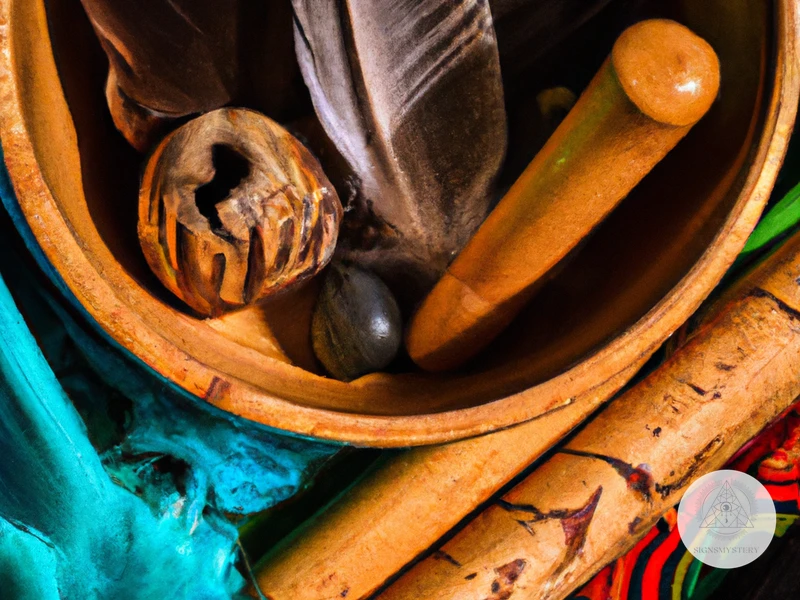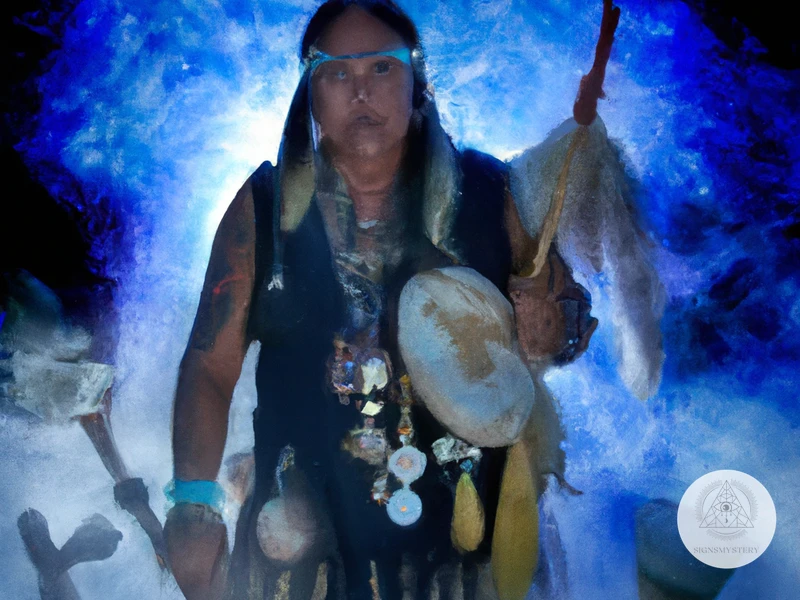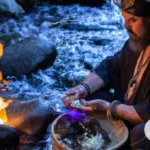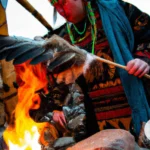Shamanism is an ancient practice that has been passed down through generations in various cultures. One of the defining aspects of shamanism is the use of tools in rituals and ceremonies. These tools are believed to have their own unique energy and assist the shaman in communicating with the spiritual world. In modern times, the use of shamanic tools has become increasingly popular as people seek to connect with their own spirituality and explore alternative forms of healing. In this article, we will explore the various types of shamanic tools, their significance in rituals, and how they are used for healing and transformation. Through a deeper understanding of the power of these tools, we can gain a greater appreciation for the wisdom and beauty of shamanic practices.
What are Shamanic Tools?

Shamanic tools are objects that are used in shamanic practices and rituals. These tools are considered as sacred instruments that help connect the shaman with the spiritual world and their inner self. The use of these tools varies depending on the tradition and the purpose of the ceremony, but they all share the same intention to assist in the communication between the physical and spiritual worlds. Some of the most common shamanic tools include drums and rattles for producing rhythmic sounds, crystals and stones for healing, feathers for energy clearing, plants and herbs for smudging and cleansing, and ceremonial clothing and accessories for honoring the spirits. The shamanic tools are powerful in their symbolism and usage, and are an essential part of any shamanic practice.
The Ancient Practices of Shamanism
The practice of shamanism dates back thousands of years and has been seen in various cultures around the world. Shamanic practices were developed as a way for individuals to connect with the spirit world and the natural world around them. The word shamanism originates from the Tungus tribe in Siberia, but similar practices have been found in Native American, African, and South American cultures, among others.
Shamans were viewed as mediators between the physical and spiritual worlds, and they believed that everything in nature had a spirit. Shamans would utilize various techniques to enter into trance-like states, such as drumming, dancing, or using sacred plants, to connect with these spirits and gain insight and guidance.
Shamans believed that illness and disease were caused by spiritual imbalances, and as such, they also developed methods for spiritual and physical healing. Shamanic healing was often carried out through ritual ceremonies that utilized various tools and techniques. The use of sound, such as chanting or music played during a ceremony, was believed to be a powerful tool for healing.
Shamanism was a way of life for many ancient cultures, and it served as a means for individuals to connect with the world around them and gain spiritual insight. Today, shamanism continues to be practiced by many individuals and communities around the world, and it remains an important part of the spiritual traditions of various cultures.
The Importance of Shamanic Tools in Modern Day Ceremonies
Shamanic tools have played a significant role in ceremonies and rituals for thousands of years. In modern times, these tools still hold great importance in contemporary shamanic practices for various reasons. One of the main reasons is that they serve as a medium for connecting with the spirits and other unseen dimensions.
Many modern-day shamanic practitioners use a combination of traditional and contemporary tools in their ceremonies. These tools allow them to tap into the spiritual realm and connect with the energies of the earth. They help them focus their intentions and channel their energy in the right direction.
Another significant importance of shamanic tools in modern-day ceremonies is that they help create a sacred space. These tools help create an environment where the energies of participants are anchored and focused. This is especially essential during shamanic cleansing rituals, where the negative energies of the participants are cleared away.
Shamanic tools used in shamanic music ceremonies provide a rhythm that enhances the mind-body connection. The drums and rattles used in these ceremonies stimulate the brainwaves, which help in attaining a trance-like state. This state is integral to achieving the desired outcome of a ritual.
In fire ceremonies and other ancestral spirit rituals, shamanic tools are used in creating a container that holds the energy of the ceremony. These tools are used to anchor the energies, intentions and protect the participants from negative forces.
The power of intention is another aspect that highlights the importance of shamanic tools in modern-day ceremonies. Shamanic tools provide a physical medium that reinforces our intention, making it more potent and significant.
Shamanic tools play an important role in modern-day ceremonies. They help create a sacred space, anchor intentions, focus energy, and connect with the spirits. Whether it’s through the use of crystals, feathers, drums or rattles, shamanic tools provide many benefits in achieving the desired outcome of a ceremony.
Types of Shamanic Tools
There are a variety of shamanic tools used in ceremony and ritual. Drums and rattles are common tools, creating sound and vibrations used to induce a trance-like state. Crystals and stones are also important, believed to hold healing energy and placed on the body during ceremonies. Feathers are used to cleanse energy and create a connection with the spirit world. Plants and herbs are often used in smudging rituals to purify a sacred space and aid in spiritual connection. And ceremonial clothing and accessories are also used to create a sacred atmosphere. Each shamanic tool has a unique purpose in the ceremony and serves to connect the practitioner with their spirit helpers or ancestors. The use of personalized tools is a common practice in shamanism, tailored to the individual’s specific needs and desires.
Drums and Rattles
Drums and rattles are some of the most popular tools used in shamanic rituals. The sound vibration created by the drums and rattles is believed to help bring the shaman into a trance-like state. This trance-like state is necessary for the shaman to connect with the spiritual world.
The drum is often considered to be the heartbeat of the earth. The shaman beats the drum in a steady rhythm, which is meant to replicate the pulsing of the earth’s energy. The drumbeat can create a rhythm for ceremonial dance, which allows the participants to unite and connect with each other and with the spiritual world.
Rattles, on the other hand, are used to produce a high-frequency sound and are often used in conjunction with the drum. The use of rattles intensifies the sound vibrations, making it easier for the shaman to enter a trance-like state. The sound of the rattle is also believed to chase away negative energy, while simultaneously invoking positive energy.
Drums and rattles are often personalized to the shaman’s individual practice. The shaman might create or select their own drum or rattle, imbuing it with their unique energy. Personalizing these tools can help build a stronger connection with the spiritual world.
In addition to their significance in shamanic rituals, these tools have also been used in mainstream society in various therapeutic practices. The sound vibrations created by drums and rattles have been shown to have a therapeutic effect on the body and mind.
Drums and rattles are important tools that have been used in shamanic rituals for centuries. These tools help shaman connect with the spiritual world, while also creating a rhythmic and therapeutic sound that benefits both the shaman and the participants.
Crystals and Stones
Crystals and stones have been utilized in shamanic rituals for centuries due to their natural energetic properties. They are believed to hold and transmit energy, and are often used to enhance personal empowerment, protection, and healing.
One commonly used crystal is quartz, known for its ability to amplify energy and intention. It is often used in ceremonies for its ability to enhance spiritual clarity and connection.
Amethyst is another popular crystal used in shamanic rituals, known for its calming and protective energy. It is believed to help balance the physical, mental, and emotional bodies, promoting overall wellness and balance.
Obsidian is a volcanic stone that has been used for centuries in shamanic practices. Due to its grounding energy, it is often used to promote inner strength and courage, while also providing protection from negative energies.
In addition to these, there are many other crystals and stones that have specific properties and uses in shamanic rituals. Some shamanic practitioners even create crystal grids, which involve placing specific stones and crystals in a geometric pattern to enhance energy flow and intention during ceremonies and rituals.
It is important to remember that while crystals and stones can be powerful tools in shamanic rituals, they are not the only aspect of the practice. They are used in conjunction with other tools, such as drums, rattles, plants, and clothing, to create a holistic and balanced ceremony.
Feathers
Feathers are one of the most significant shamanic tools used in rituals and ceremonies. They are considered sacred objects in many cultures around the world and play an essential role in connecting the shaman with the spiritual realm. There are many different types of feathers used in shamanic practices, each with its own unique meaning and purpose.
Eagle Feathers
Eagle feathers are one of the most powerful and highly regarded types of feathers used in shamanic ceremonies. Eagles are seen as messengers between the spiritual and physical world, and their feathers are thought to carry this communication. In many Native American tribes, eagle feathers are a symbol of honor, bravery, and courage and are granted only to those who have demonstrated these qualities.
Owl Feathers
Owl feathers are another important shamanic tool as they represent wisdom, intuition, and psychic insight. Owls are known for their acute senses and are often associated with the ability to see beyond illusion and deception. The feathers of owls are sometimes used in ceremonies to help the shaman see through the veil of illusion and connect with the spiritual realm.
Turkey Feathers
Turkey feathers are commonly used in smudging rituals and are believed to have powerful cleansing properties. The feathers of turkeys are also used in many traditional dances and ceremonies and are said to symbolize abundance and generosity.
Peacock Feathers
Peacock feathers are often used in shamanic rituals to represent the cycle of death and rebirth. The beautiful iridescent feathers are a symbol of transformation, renewal, and the cyclical nature of life.
Swan Feathers
The feathers of swans are considered to be extremely potent shamanic tools and are often used to help the shaman connect with the energy of the water element. Swans are associated with grace, beauty, and purity and are believed to bring balance and harmony to the spirit.
Feathers play an essential role in shamanic rituals and ceremonies, connecting the shaman with the spiritual realm and helping to facilitate transformation and healing. Each type of feather used in shamanic practices has its own unique purpose and meaning, and understanding their significance can enhance one’s experience of these ancient practices. If you want to learn more about shamanic rituals in general, you can read our article on ancestral spirit rituals, or you can also read our article on sacred plants in shamanic ceremonies to learn about the various plants used in these powerful ceremonies.
Plants and Herbs
Plants and herbs have been utilized in shamanic practices for centuries. These natural elements are believed to possess spiritual properties that can aid in the rituals and ceremonies carried out by shamans.
Ayahuasca is one of the most well-known shamanic plant medicines. It is a brew made from the ayahuasca vine and the leaves of the chacruna plant. Ayahuasca has been used in shamanic ceremonies for centuries by shamans in South America. It is known for its powerful hallucinogenic properties and is often used for spiritual healing and exploration.
Sage is another common plant used by shamans in their rituals. It is known for its cleansing and purifying properties and is often burned as a smudge to clear negative energy from a space or person. Shamans also use sage to connect with the spirit world during their ceremonies.
Tobacco is a sacred plant that is used in shamanic practices across the world. It is believed to have grounding and protective properties and is often used to create a protective barrier around the shaman during their ceremonies. It is also used as an offering to the spirits.
San Pedro, also known as Huachuma, is a cactus that is native to the Andes Mountains in South America. It is used in shamanic ceremonies for spiritual healing and growth. It contains the psychoactive compound mescaline, which induces powerful visions and can aid in spiritual exploration.
Cedar is another plant that is commonly used in shamanic practices. It is known for its cleansing properties and is often used in ceremonial smudging. Cedar is also believed to have protective properties and is used to ward off negative energy.
Plants and herbs play a vital role in shamanic practices. They are believed to possess powerful spiritual properties that can aid in healing, spiritual exploration, and connection with the spirit world. Shamans have a deep understanding of the energy and properties of these natural elements, and they use them with great respect and intention in their ceremonies.
Ceremonial Clothing and Accessories
Ceremonial clothing and accessories play an important role in shamanic rituals and ceremonies, as they help to connect the shaman and participants with the spiritual realm. These clothing and accessories are specially designed to represent the power and energy of the shaman and the spiritual entities they work with.
One of the most commonly used accessories in shamanic ceremonies is the headdress. The headdress is worn by the shaman or other participants to symbolize their connection with the divine, and to show their respect to the spirits. Headdresses are often made of natural materials such as feathers, beads, and animal fur, and are decorated with intricate designs and symbols that represent the shaman’s spiritual journey.
Another important accessory is the amulet, which is a small object that is believed to have magical or spiritual powers. Amulets are often worn as necklaces or bracelets, and can be made from a variety of materials such as crystals, stones, shells, and bones. They are used to protect the wearers from negative energies and to attract positive energies.
In addition to headdresses and amulets, ceremonial clothing is also an important aspect of shamanic ceremonies. The clothing worn by the shaman and other participants is often made from natural materials such as animal skin and fibres, and is decorated with symbols and designs that represent their spiritual path. For example, a shaman may wear a cape made from feathers to represent their ability to soar to great spiritual heights.
Ceremonial clothing and accessories are important tools for shamanic practitioners, as they help to create
Subscribe to Our Newsletter
Sign up to receive the latest news and updates.
How Shamanic Tools are Used in Rituals
Shamanic tools are an important part of rituals and ceremonies, allowing shamans and participants to connect with the spiritual world and facilitate healing and transformation. One of the ways these tools are used is through sound and vibration, which can alter consciousness and induce a trance-like state. Drums and rattles are common tools used for this purpose, as well as for calling in spirits and setting the tone for the ceremony. Sacred objects, such as crystals, feathers, and plants, can also be used for their specific properties and symbolism. These objects are often incorporated into ritual altars or medicine bags and carried by the shaman or participants. Finally, shamanic tools can be used for healing and transformation, whether physical, emotional, or spiritual. For example, plants and herbs may be burned or ingested for their medicinal properties, while crystals may be placed on the body to balance energies. The uses of shamanic tools in rituals and ceremonies are diverse and powerful, offering a unique opportunity for connection with the spiritual realm.
The Power of Sound and Vibration
Shamanic tools are often used in ceremonies to produce sounds and vibrations that are believed to have healing and transformative effects. The power of sound and vibration has been recognized for thousands of years in various cultures around the world. Shamanic practices utilize different types of tools to produce sound and vibration, such as drums, rattles, bells, and singing bowls. These sounds are used to create a sacred environment and influence the consciousness of participants.
Drums: Drums are the most common shamanic tool used for sound and vibration. The sound of the drumbeat is believed to alter the brainwave patterns of participants, inducing a trance-like state. This state allows participants to journey to other realms and connect with spiritual guides. The rhythmic beat of the drum is also used for grounding and centering, enabling participants to focus their attention and release negative emotions.
Rattles: Rattles are another common shamanic tool that produces sound and vibration. The sound of the rattles is believed to break up stagnant energy and clear blockages in the body, promoting healing and transformation. The vibration created by the rattles is also thought to activate the chakras, the energy centers of the body, promoting balance and harmony.
Singing Bowls: Singing bowls are used in shamanic practices to produce a variety of sounds and vibrations. The bowls are struck or played with a mallet, producing a deep and resonant tone. The vibration created by the singing bowl is believed to balance the energetic body and promote relaxation.
Bells: Bells are often used in shamanic practices to signal the beginning and end of a ceremony. The sound of the bell is believed to disperse negative energy and invite positive energy into the space. The ringing of the bell is also used to invoke spiritual beings and entities.
Chants and Mantras: Chants and mantras are spoken or sung in shamanic practices to produce a rhythmic sound and vibration. The repetition of these sounds is believed to induce a meditative state, promoting inner peace and tranquility. The vibration created by the chanting is also believed to activate the chakras and promote healing.
The power of sound and vibration is a significant aspect of shamanic practices. Shamanic tools are used to produce different sounds and vibrations that are believed to induce trance-like states, promote healing and transformation, and connect participants with spiritual guides and entities. The use of sound and vibration in shamanic practices highlights the significance of the connection between the physical and energetic body, promoting balance, harmony, and inner peace.
The Significance of Sacred Objects
The use of sacred objects in shamanic rituals and ceremonies is crucial. These objects hold significant spiritual and symbolic meaning, and they aid in the shaman’s connection with the spirit world. Below are some sacred objects commonly used in shamanic practices and their significance:
| Sacred Object | Significance |
|---|---|
| Feathers | Feathers are often used in shamanic practices as they are believed to connect the user to the spirit world. They represent the ability to transcend above the physical realm and communicate with spirits. Different types of feathers hold different meanings, such as the eagle feather representing strength and courage. |
| Masks | Shamanic masks are used to conceal the shaman’s identity and allow them to become one with the spirit they are channeling. They are believed to possess the spirit of the creature they represent, and when worn, they transform the wearer into that spirit. |
| Crystals and Stones | Crystals and stones are often used for their healing properties in shamanic practices. They are believed to hold energy and can be used to balance and align chakras or cleanse negative energy. Different types of stones hold different meanings, such as clear quartz representing clarity and spiritual growth. |
| Animal Bones | Animal bones are used in shamanic practices as they are believed to hold the spirit and energy of the animal they came from. They can be used for divination purposes or as tools to connect with the animal spirit. Each bone holds its own unique energy and significance. |
By incorporating these sacred objects into shamanic rituals and ceremonies, the shaman is able to connect with the spirit world and facilitate healing and transformation. These objects are revered and respected, as they hold immense spiritual power and significance in shamanic practices.
Using Shamanic Tools for Healing and Transformation
When it comes to using shamanic tools for healing and transformation, there are a variety of techniques that can be employed. One of the most common ways that shamanic healers use tools is by incorporating sound into their healing practices. Drums and rattles, for example, can be used to create rhythmic vibrations that help to shift the energetic patterns in a person’s body.
Another common technique is the use of crystals and stones. Different stones are believed to have different properties, such as promoting grounding, protection, or emotional balance. A shamanic healer may place these stones on or near a person’s body to help bring about a specific healing effect.
Feathers are also a common tool used in shamanic healing. These can be used to cleanse a person’s energy field, or to help guide a person through a spiritual journey. Similarly, plants and herbs may be used to create healing teas, smudging blends, or tinctures that can be ingested or applied to the body.
Ceremonial clothing and accessories may also be used in shamanic healing practices. For example, a shamanic healer may wear a headdress or carry a wand that has specific energetic properties. These items can help the healer to channel and direct energy during a healing session.
Ultimately, the use of shamanic tools for healing and transformation is based on the belief that the energetic patterns in a person’s body can be shifted and transformed through the use of various techniques. While the specific tools used may vary from healer to healer, the underlying principles remain the same: that all things are connected, and that by working with the energies of the natural world, we can bring about profound healing and transformation in ourselves and in others.
Conclusion
Conclusion:
In conclusion, it is clear that shamanic tools play an important role in rituals and ceremonies both in ancient times and in modern day practices. These tools serve as a bridge between the physical and spiritual realms, allowing practitioners to connect with the deeper aspects of themselves and the universe. The use of shamanic tools such as drums, rattles, crystals, stones, feathers, and plants can enhance the power of rituals and ceremonies, bringing about healing, transformation, and spiritual growth.
The use of sound and vibration through drums and rattles can help shift energy and create a sacred space for the ceremony or ritual. Crystals and stones have their own unique energies and properties, which can be used to amplify intentions and aid in healing. Feathers, which are considered sacred in many indigenous traditions, can be used to symbolize the connection with the spirit world. Plants and herbs, which have been used for medicinal purposes for thousands of years, can also be used to promote healing and spiritual growth.
In modern day practices, the use of shamanic tools has become more accessible and mainstream. Workshops and retreats are being held around the world, where participants can learn about shamanic tools and their uses in rituals and ceremonies.
In essence, shamanic tools are an integral part of many spiritual practices, serving as a means of connection to the spiritual world, to oneself, and to others. As the world becomes more fast-paced and disconnected from nature, the use of shamanic tools can provide a way to reconnect with the natural rhythms and energies of the universe. Through the use of these tools, individuals can tap into their inner wisdom and gain a deeper understanding of themselves, others, and the world around them.
Frequently Asked Questions
What is the significance of shamanic tools in ceremonies?
Shamanic tools play a crucial role in rituals and ceremonies. They help create a sacred space and allow the shaman to connect with spiritual entities. Additionally, they can facilitate healing, transformation, and journeying.
What are some common shamanic tools?
Some common shamanic tools include drums, rattles, crystals, stones, feathers, plants and herbs, and ceremonial clothing and accessories.
What is the purpose of a shamanic drum?
A shamanic drum is used to create a rhythmic beat that helps induce a state of altered consciousness. It can also be used to call in spirits or help drive out negative energy.
Why are crystals and stones used in shamanic ceremonies?
Crystals and stones are believed to contain healing and spiritual properties. They can be used to enhance energetic vibrations, cleanse negative energy, and amplify intentions.
Can anyone use shamanic tools, or do you need special training?
While anyone can technically use shamanic tools, it is recommended that you receive proper training from an experienced shaman or practitioner. This will help ensure that you are using them safely and effectively.
How do feathers come into play in shamanic ceremonies?
Feathers are often used to cleanse and purify energy, as well as to honor and symbolize the presence of spirit guides and guardians.
What is the significance of plants and herbs in shamanism?
Plants and herbs are used in shamanic ceremonies for their medicinal and spiritual properties. They can be used to help induce a state of ecstasy, facilitate communication with spirits, and heal physical and emotional imbalances.
How can shamanic tools be used for healing?
Shamanic tools can be used to facilitate healing by helping the practitioner enter a state of altered consciousness and connect with the spiritual realm. They can also be used to clear blockages, remove negative energy, and restore balance to the body and mind.
Are there any risks associated with using shamanic tools?
There are some risks associated with using shamanic tools, particularly if they are used improperly or without proper guidance. It is important to be aware of potential risks, such as accidentally opening oneself up to negative energies or becoming overly reliant on the tools themselves.
Can shamanic tools be used in conjunction with other spiritual practices?
Yes, shamanic tools can be used in conjunction with a variety of other spiritual practices, including meditation, yoga, and energy healing. It is important, however, to ensure that you have a thorough understanding of each practice and how they interact with each other.










